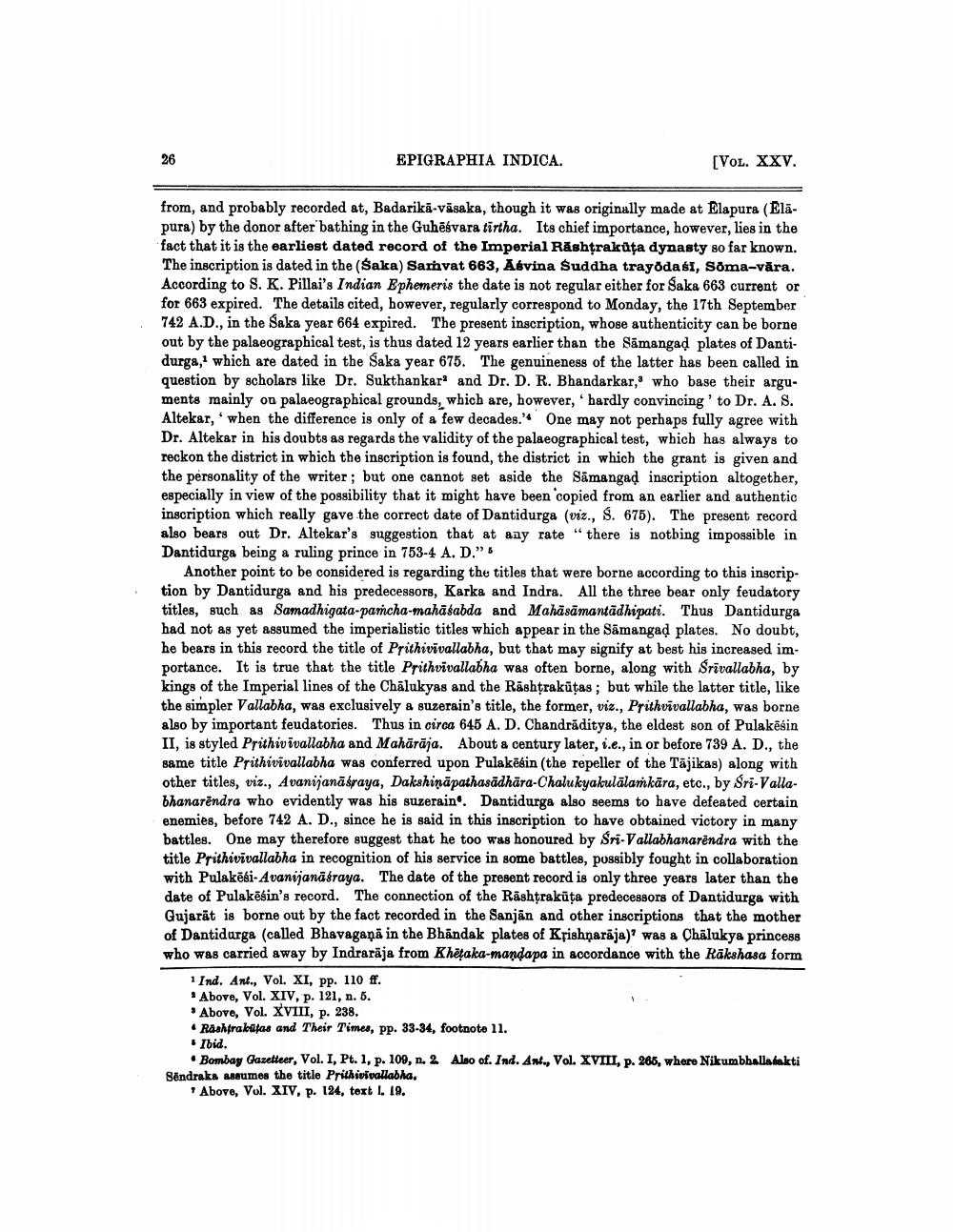________________
26
EPIGRAPHIA INDICA.
[VOL. XXV.
from, and probably recorded at, Badarika-vasaka, though it was originally made at Elapura (Elāpura) by the donor after bathing in the Guhesvara tirtha. Its chief importance, however, lies in the fact that it is the earliest dated record of the Imperial Rashtrakuta dynasty so far known. The inscription is dated in the (Saka) Samvat 663, Aévina Suddha trayōdaśī, Sōma-vāra. According to S. K. Pillai's Indian Ephemeris the date is not regular either for Saka 663 current or for 663 expired. The details cited, however, regularly correspond to Monday, the 17th September 742 A.D., in the Saka year 664 expired. The present inscription, whose authenticity can be borne out by the palaeographical test, is thus dated 12 years earlier than the Samangaḍ plates of Dantidurga, which are dated in the Saka year 675. The genuineness of the latter has been called in question by scholars like Dr. Sukthankar and Dr. D. R. Bhandarkar, who base their arguments mainly on palaeographical grounds, which are, however, hardly convincing' to Dr. A. S. Altekar, when the difference is only of a few decades. One may not perhaps fully agree with Dr. Altekar in his doubts as regards the validity of the palaeographical test, which has always to reckon the district in which the inscription is found, the district in which the grant is given and the personality of the writer; but one cannot set aside the Samangaḍ inscription altogether, especially in view of the possibility that it might have been copied from an earlier and authentic inscription which really gave the correct date of Dantidurga (viz., S. 675). The present record also bears out Dr. Altekar's suggestion that at any rate "there is nothing impossible in Dantidurga being a ruling prince in 753-4 A. D."
Another point to be considered is regarding the titles that were borne according to this inscription by Dantidurga and his predecessors, Karka and Indra. All the three bear only feudatory titles, such as Samadhigata-pamcha-mahāśabda and Mahāsāmantādhipati. Thus Dantidurga had not as yet assumed the imperialistic titles which appear in the Samangaḍ plates. No doubt, he bears in this record the title of Prithivivallabha, but that may signify at best his increased importance. It is true that the title Prithvivallabha was often borne, along with Srivallabha, by kings of the Imperial lines of the Chalukyas and the Rashtrakutas; but while the latter title, like the simpler Vallabha, was exclusively a suzerain's title, the former, viz., Prithvivallabha, was borne also by important feudatories. Thus in circa 645 A. D. Chandraditya, the eldest son of Pulakesin II, is styled Prithivivallabha and Mahārāja. About a century later, i.e., in or before 739 A. D., the same title Prithivivallabha was conferred upon Pulakesin (the repeller of the Tajikas) along with other titles, viz., Avanijanāśraya, Dakshinapathasādhāra-Chalukyakulālaṁkāra, etc., by Sri-Vallabhanarendra who evidently was his suzerain. Dantidurga also seems to have defeated certain enemies, before 742 A. D., since he is said in this inscription to have obtained victory in many battles. One may therefore suggest that he too was honoured by Sri-Vallabhanarendra with the title Prithivivallabha in recognition of his service in some battles, possibly fought in collaboration with Pulakesi-Avanijanasraya. The date of the present record is only three years later than the date of Pulakesin's record. The connection of the Rashtrakuța predecessors of Dantidurga with Gujarat is borne out by the fact recorded in the Sanjan and other inscriptions that the mother of Dantidurga (called Bhavagana in the Bhandak plates of Krishnaraja)' was a Chalukya princess who was carried away by Indraraja from Khetaka-mandapa in accordance with the Rakshasa form
1 Ind. Ant., Vol. XI, pp. 110 ff.
Above, Vol. XIV, p. 121, n. 5.
* Above, Vol. XVIII, p. 238.
• Rashtrakutas and Their Times, pp. 33-34, footnote 11.
Ibid.
• Bombay Gazetteer, Vol. I, Pt. 1, p. 109, n. 2. Also of. Ind. Ant., Vol. XVIII, p. 265, where Nikumbhalla akti Sendraka assumes the title Prithivivallabha.
Above, Vol. XIV, p. 124, text I. 19.




